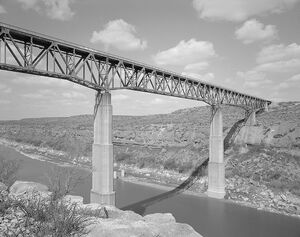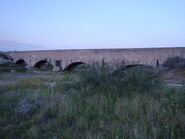Judy alvarez (talk | contribs) (Created page with "{{Geobox|River | name = Pecos River | other_name = Río Pecos | category = River | category_hide = 1 | image = Pecos river bridge.jpg | image_caption = [[Pecos River High Bridge]...") |
Judy alvarez (talk | contribs) No edit summary |
||
| (3 intermediate revisions by the same user not shown) | |||
| Line 12: | Line 12: | ||
| region = |
| region = |
||
| source = Pecos Falls |
| source = Pecos Falls |
||
| − | | source_location = |
+ | | source_location = 29 miles north of [[Pecos, New Mexico]] |
| source_region = |
| source_region = |
||
| source_elevation_imperial = 11759 |
| source_elevation_imperial = 11759 |
||
| source_elevation_note = |
| source_elevation_note = |
||
| − | | source_lat_d = 35| source_lat_m = 58| source_lat_s = 34| source_lat_NS =N| source_long_d = 105| source_long_m = 33| source_long_s = 29| source_long_EW =W |
||
| − | | source_coordinates_note = <ref name=GNIS>{{Gnis|1384150|Pecos River}}</ref> |
||
| mouth = [[Rio Grande]] |
| mouth = [[Rio Grande]] |
||
| − | | mouth_location = Seminole Canyon, [[Val Verde County, Texas|Val Verde County]], {{convert|37|mi|km|abbr=on}} northwest of [[Del Rio, Texas]] |
+ | | mouth_location = Seminole Canyon, [[Val Verde County, Texas|Val Verde County]], {{convert|37|mi|km|0|abbr=on}} northwest of [[Del Rio, Texas]] |
| mouth_region = |
| mouth_region = |
||
| mouth_elevation_imperial = 1115 |
| mouth_elevation_imperial = 1115 |
||
| mouth_elevation_note = |
| mouth_elevation_note = |
||
| − | | mouth_lat_d = 29| mouth_lat_m = 41| mouth_lat_s = 59| mouth_lat_NS =N |
||
| − | | mouth_long_d = 101| mouth_long_m = 22| mouth_long_s = 17| mouth_long_EW =W |
||
| mouth_coordinates_note = <ref name=GNIS/> |
| mouth_coordinates_note = <ref name=GNIS/> |
||
| length_imperial = 926 |
| length_imperial = 926 |
||
| Line 40: | Line 36: | ||
| commons = |
| commons = |
||
}} |
}} |
||
| + | |||
| − | The headwaters of the '''Pecos River''' are located north of [[Pecos, New Mexico]], [[United States]], at an elevation of over 12,000 feet on the western slope of the Sangre de Cristo mountain range in Mora County<ref>http://www.ose.state.nm.us/isc_pecos.html</ref>. The river flows for |
+ | The headwaters of the '''Pecos River''' are located north of [[Pecos, New Mexico]], [[United States]], at an elevation of over 12,000 feet on the western slope of the Sangre de Cristo mountain range in Mora County<ref>http://www.ose.state.nm.us/isc_pecos.html</ref>. The river flows for 926 miles through the eastern portion of that state and neighboring [[Texas]] before it empties into the [[Rio Grande]] near [[Del Rio, Texas|Del Rio]]. The river's [[drainage basin]] is approximately {{convert|44300|sqmi|km2|0}} in size.<ref name=largest>[http://pubs.usgs.gov/of/1987/ofr87-242/ Largest Rivers of the United States], USGS</ref> |
==Modifications== |
==Modifications== |
||
| − | There are multiple dams along the Pecos River. [http://www.emnrd.state.nm.us/PRD/santarosa.htm Santa Rosa Lake] is 117 miles/188 kM east of Albuquerque. [http://www.emnrd.state.nm.us/PRD/SumnerLake.htm Sumner Lake] is located between Santa Rosa and Fort Sumner, NM. Two dams are located north of [[Carlsbad, New Mexico]], at Avalon Reservoir and Lake McMillan, to help irrigate about {{convert|25000|acre|ha}} as part of the Carlsbad reclamation project (established in 1906). Texas has also dammed the river at the [[Red Bluff Dam]] in the western part of that state to form the [[Red Bluff Reservoir]]. The portion of the reservoir that extends into New Mexico forms the lowest point in that state. |
+ | There are multiple dams along the Pecos River. [http://www.emnrd.state.nm.us/PRD/santarosa.htm Santa Rosa Lake] is 117 miles/188 kM east of Albuquerque. [http://www.emnrd.state.nm.us/PRD/SumnerLake.htm Sumner Lake] is located between Santa Rosa and Fort Sumner, NM. Two dams are located north of [[Carlsbad, New Mexico]], at Avalon Reservoir and Lake McMillan, to help irrigate about {{convert|25000|acre|ha|0}} as part of the Carlsbad reclamation project (established in 1906). Texas has also dammed the river at the [[Red Bluff Dam]] in the western part of that state to form the [[Red Bluff Reservoir]]. The portion of the reservoir that extends into New Mexico forms the lowest point in that state. |
==History== |
==History== |
||
| Line 62: | Line 59: | ||
The Flume is a modern aqueduct carrying irrigation water over the Pecos River. |
The Flume is a modern aqueduct carrying irrigation water over the Pecos River. |
||
| − | Construction took place from 1889 to 1890 and was part of the Pecos River Reclamation Project. It was originally constructed of wood and spanned |
+ | Construction took place from 1889 to 1890 and was part of the Pecos River Reclamation Project. It was originally constructed of wood and spanned 145ft. It carried water at a depth of 8 feet. In 1902, a flood destroyed the Flume and it was subsequently rebuilt using concrete. In 1902, it was the largest concrete structure in the world. |
The Flume and its surrounding area have been reclaimed by the city of [[Carlsbad, New Mexico|Carlsbad]] and has been transformed into a tourist attraction with park improvements along the river and spot lights to give a spectacular nightly view. |
The Flume and its surrounding area have been reclaimed by the city of [[Carlsbad, New Mexico|Carlsbad]] and has been transformed into a tourist attraction with park improvements along the river and spot lights to give a spectacular nightly view. |
||
<gallery> |
<gallery> |
||
| − | File:Pecos River Flume Night. |
+ | File:Pecos River Flume Night.jpg|Pecos River Flume Night |
| − | File:Pecos River Flume 2. |
+ | File:Pecos River Flume 2.jpg|Pecos River Flume |
| − | File:Pecos River Flume Top. |
+ | File:Pecos River Flume Top.jpg|Pecos River Flume Top |
</gallery> |
</gallery> |
||
| Line 85: | Line 82: | ||
==External links== |
==External links== |
||
*{{Handbook of Texas|id=PP/rnp2|name=Pecos River}} |
*{{Handbook of Texas|id=PP/rnp2|name=Pecos River}} |
||
| − | |||
[[Category:Rio Grande basin]] |
[[Category:Rio Grande basin]] |
||
[[Category:Rivers of New Mexico]] |
[[Category:Rivers of New Mexico]] |
||
Latest revision as of 04:46, 7 April 2011
Pecos River High Bridge, near Langtry, Val Verde County, Texas
| |
The headwaters of the Pecos River are located north of Pecos, New Mexico, United States, at an elevation of over 12,000 feet on the western slope of the Sangre de Cristo mountain range in Mora County[1]. The river flows for 926 miles through the eastern portion of that state and neighboring Texas before it empties into the Rio Grande near Del Rio. The river's drainage basin is approximately 44,300 square miles (114,736 km2) in size.[2]
Modifications[]
There are multiple dams along the Pecos River. Santa Rosa Lake is 117 miles/188 kM east of Albuquerque. Sumner Lake is located between Santa Rosa and Fort Sumner, NM. Two dams are located north of Carlsbad, New Mexico, at Avalon Reservoir and Lake McMillan, to help irrigate about 25,000 acres (10,117 ha) as part of the Carlsbad reclamation project (established in 1906). Texas has also dammed the river at the Red Bluff Dam in the western part of that state to form the Red Bluff Reservoir. The portion of the reservoir that extends into New Mexico forms the lowest point in that state.
History[]
The river played a large role in the exploration of Texas by the Spanish. In the latter half of the 19th century, "West of the Pecos" was a reference to the rugged frontiers of the Wild West.
New Mexico and Texas disputed water rights to the river until the federal government settled the dispute in 1949 with the Pecos River Compact. The Pecos River Settlement Agreement was signed between New Mexico and Texas in 2003.
Wild and Scenic River[]
On June 6, 1990, 20.5 miles (33 km) of the Pecos River—from its headwaters to the townsite of Tererro—received National Wild and Scenic River designation. It includes 13.5 miles (22 km) designated "wild" and 7 miles (11 km) designated "recreational."[3]
Pecos River Flume[]
The Flume is a modern aqueduct carrying irrigation water over the Pecos River. Construction took place from 1889 to 1890 and was part of the Pecos River Reclamation Project. It was originally constructed of wood and spanned 145ft. It carried water at a depth of 8 feet. In 1902, a flood destroyed the Flume and it was subsequently rebuilt using concrete. In 1902, it was the largest concrete structure in the world.
The Flume and its surrounding area have been reclaimed by the city of Carlsbad and has been transformed into a tourist attraction with park improvements along the river and spot lights to give a spectacular nightly view.
See also[]
- List of tributaries of the Rio Grande
- List of rivers of New Mexico
- List of rivers of Texas
- USS Pecos (AO-6) — a fleet oiler built in 1921.
- USS Pecos (AO-65) — a fleet oiler built in 1942.
- USNS Pecos (T-AO-197) — an underway replenishment oiler built in 1990.
References[]
- ↑ http://www.ose.state.nm.us/isc_pecos.html
- ↑ Largest Rivers of the United States, USGS
- ↑ Pecos Wild and Scenic River, New Mexico - National Wild and Scenic Rivers System
External links[]
- Pecos River from the Handbook of Texas Online







